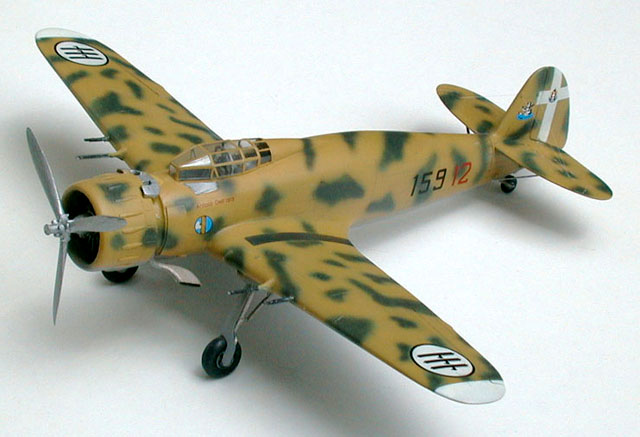|
Breda Ba 65 A80
by Chris
Busbridge
|

|
|
Breda Ba 65 A80 |

HyperScale
is proudly supported by
Squadron.com
This is the Warrior 1/48 scale resin kit of the
Breda Ba 65.
I ordered the model from Pacific Coast Models, the
only store that had it in stock. Having missed out on the RCR resin kit
(which is long out of production) this makes the Warriors offering the
only 1/48 scale model of this strange, aggressive looking aircraft you
can buy.
I really like the unusual appearance of this
aircraft, especially the single seater or "monoposto" version.
In its original K14 guise it had a rear gunner, but
the extra weight hampered its in-flight performance to such a degree
that this was quickly dropped. Surviving pilots who flew this plane had
few good words to say about it. Because of outdated training techniques,
the take-off and landing was a dangerous operation for all concerned and
the engine had to stay on full chat just to keep it in the air.
Acrobatics were a definite no-no.
The A80 model had an uprated engine that improved
matters, but it still needed expert pilot skills to get the best out of
the plane. Having been removed from service after the Spanish campaign,
they were destined for the scrapheap. Due to a shortage of other
suitable planes the Regia Aeronautica had them reintroduced, where they
had somewhat belated success as a ground attack aircraft during the
North African campaign.
The loss rate was very high and the tough desert
conditions left any remaining aircraft inoperative.
Before I started, I bought the Ba 65 Ali d'Italia
book, a very useful source for checking accuracy and detail as well as
checking out the colour scheme.
Some of the cockpit detail included white metal parts for the tubular
framework. They were a bit fragile, but when fully assembled it captured
the busy cockpit environment very well.

The rear-gunner version of the A80 is built straight out of the box,
whereas the "monoposto" version requires a bit of surgery. This involved
removing the rear gunner portion and replacing it with a blank section.
I used Milliput to blend it in. More Milliput was used on other areas of
the fuselage to correct its cross-section and to get a good fit between
the fuselage and cockpit canopy. This is the only serious critique I
have of the kit. The Ali d'Italia book came into its own here, as the
plans left little doubt as to what the fuselage shape ought to be. An
opening needs to be made in the ventral fuselage area for the vacform
rear gunner observation window, which was retained in the monoposto
airframe. The framing for this and the cockpit canopy looked heavy but
once masked and sprayed they worked very well.
The rest of the construction is pretty normal for such a limited run
kit, but a few tweaks are still necessary. The plans showed up a number
of minor errors, such as the shape of the elevators, the trailing edge
of the wings, undercarriage doors, cowling vane detail and the holes in
the bomb bay doors. All are easily fixed. Another simple correction was
to extended the port wing by 2mm at the wing tip, as the real aircraft
had a slightly longer span to compensate for engine torque.
I used Humbrol paints throughout. The kit decals worked surprisingly
well, but there is an error in the spelling of the name on the fuselage.
It should read "Oro" not "ara", not that anyone would notice!
The fuselage shape correction made for a challenging build, but it did
make it all the more satisfying when it was finally finished.
Model, Images and Text Copyright © 2002 by
Chris Busbridge
Page Created 29 October, 2002
Last Updated 04 June, 2007
Back to HyperScale
Main Page
Back to
Features Index
|
Home
| What's New |
Features |
Gallery |
Reviews |
Reference |
Forum |
Search